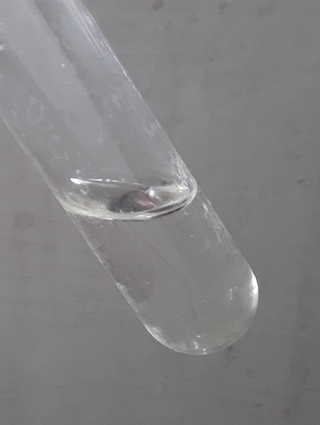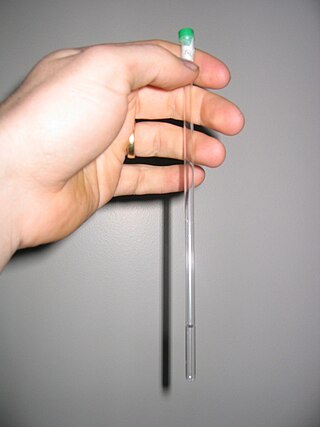Related Research Articles

Paint is a material or mixture that, when applied to a solid material and allowed to dry, adds a film-like layer. As art, this is used to create an image or images known as a painting. Paint can be made in many colors and types. Most paints are either oil-based or water-based, and each has distinct characteristics.

Toluene, also known as toluol, is a substituted aromatic hydrocarbon with the chemical formula C6H5CH3, often abbreviated as PhCH3, where Ph stands for the phenyl group. It is a colorless, water-insoluble liquid with the odor associated with paint thinners. It is a mono-substituted benzene derivative, consisting of a methyl group (CH3) attached to a phenyl group by a single bond. As such, its systematic IUPAC name is methylbenzene. Toluene is predominantly used as an industrial feedstock and a solvent.

A solvent is a substance that dissolves a solute, resulting in a solution. A solvent is usually a liquid but can also be a solid, a gas, or a supercritical fluid. Water is a solvent for polar molecules, and the most common solvent used by living things; all the ions and proteins in a cell are dissolved in water within the cell.

Butanone, also known as methyl ethyl ketone (MEK) or ethyl methyl ketone, is an organic compound with the formula CH3C(O)CH2CH3. This colorless liquid ketone has a sharp, sweet odor reminiscent of acetone. It is produced industrially on a large scale, but occurs in nature only in trace amounts. It is partially soluble in water, and is commonly used as an industrial solvent. It is an isomer of another solvent, tetrahydrofuran.

Varnish is a clear transparent hard protective coating or film. It is not to be confused with wood stain. It usually has a yellowish shade due to the manufacturing process and materials used, but it may also be pigmented as desired. It is sold commercially in various shades.

Lacquer is a type of hard and usually shiny coating or finish applied to materials such as wood or metal. It is most often made from resin extracted from trees and waxes and has been in use since antiquity.

White spirit (AU, UK and Ireland) or mineral spirits (US, Canada), also known as mineral turpentine (AU/NZ/ZA), turpentine substitute, and petroleum spirits, is a petroleum-derived clear liquid used as a common organic solvent in painting. There are also terms for specific kinds of white spirit, including Stoddard solvent and solvent naphtha (petroleum). White spirit is often used as a paint thinner, or as a component thereof, though paint thinner is a broader category of solvent. Odorless mineral spirits (OMS) have been refined to remove the more toxic aromatic compounds, and are recommended for applications such as oil painting.

A paint thinner is a solvent used to dilute oil-based paints or varnish. In this context, to dilute is also known as to 'thin'. Paint thinners are diluents. Solvents labeled "paint thinner" are usually white or mineral spirits.

Rubber cement is an adhesive made from elastic polymers mixed in a solvent such as acetone, hexane, heptane or toluene to keep it fluid enough to be used. This makes it part of the class of drying adhesives: as the solvents quickly evaporate, the rubber solidifies, forming a strong yet flexible bond.
Japan black is a lacquer or varnish suitable for many substrates but known especially for its use on iron and steel. It can also be called japan lacquer and Brunswick black. Its name comes from the association between the finish and Japanese products in the West. Used as a verb, japan means "to finish in japan black". Thus japanning and japanned are terms describing the process and its products.

Acetone is an organic compound with the formula (CH3)2CO. It is the simplest and smallest ketone. It is a colorless, highly volatile, and flammable liquid with a characteristic pungent odour, very reminiscent of the smell of pear drops.

A primer or undercoat is a preparatory coating put on materials before painting. Priming ensures better adhesion of paint to the surface, increases paint durability, and provides additional protection for the material being painted.

Methyl isobutyl ketone (MIBK, 4-methylpentan-2-one) is an organic compound with the condensed chemical formula (CH3)2CHCH2C(O)CH3. This ketone is a colourless liquid that is used as a solvent for gums, resins, paints, varnishes, lacquers, and nitrocellulose.

An NMR tube is a thin glass walled tube used to contain samples in nuclear magnetic resonance spectroscopy. Typically NMR tubes come in 5 mm diameters but 10 mm and 3 mm samples are known. It is important that the tubes are uniformly thick and well-balanced to ensure that NMR tube spins at a regular rate, usually about 20 Hz in the NMR spectrometer.

Automotive paint is paint used on automobiles for both protective and decorative purposes. Water-based acrylic polyurethane enamel paint is currently the most widely used paint for reasons including reducing paint's environmental impact.

In fire protection, an accelerant is any substance or mixture that accelerates or speeds the development and escalation of fire. Accelerants are often used to commit arson, and some accelerants may cause an explosion. Some fire investigators use the term "accelerant" to mean any substance that initiates and promotes a fire without implying intent or malice. The accelerant works by burning rapidly. As such, the accelerant itself is consumed in the process, and should not be considered as a catalyst. In Arson investigation, the significance of accelerant is to detect the presence of a such substance in order to proved that the fire is classified as an arson.
Isopropyl alcohol is a colorless, flammable, organic compound with a pungent alcoholic odor.

Reactive diluents are substances which reduce the viscosity of a lacquer or resin for processing and become part of the lacquer or coating during its subsequent curing via copolymerization. A non-reactive diluent would be a solvent or plasticizer.

Brake cleaner, often also called parts cleaner, is a mostly colorless cleaning agent, mainly used for cleaning the brake disks, the engine compartment and underfloor of motor vehicles. An important feature is that the brake cleaner leaves no residue after the solvents evaporate.
VOC exempt solvents are organic compounds that are exempt from restrictions placed on most volatile organic compounds (VOCs) in the United States. This class of solvent currently includes acetone, dimethyl carbonate, methyl acetate, parachlorobenzotrifluoride, tert-Butyl acetate, and propylene carbonate. The definition is often that they do not contribute to ozone or ozone depletion.
References
- ↑ NPCS Board of Consultants & Engineers (9 July 2017). Manufacture of Thinners & Solvents (Properties, Uses, Production, Formulation with Machinery Details). Niir Project Consultancy Services. ISBN 978-93-81039-83-0.
- ↑ Bottens, Bernie. "What chemicals are in your lacquer thinner?". The Woodworking Network. Retrieved August 20, 2016.
- ↑ "General Purpose Low VOC Lacquer Thinner, 5 Gallon" . Retrieved 2018-04-09.
- ↑ "Enamel vs Lacquer vs Acrylic Model Paints" . Retrieved 2022-02-25.